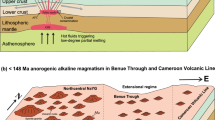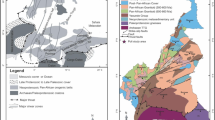Abstract
The Baishitouquan amazonite and topaz-bearing granite is one of the typical high-rubidium and high-fluorine granites in the eastern part of the Mid-Tianshan belt. This intrusion is in sharp contact with Mid-Proterozoic schists, gneisses and marbles, and is composed of four zones transitional from the bottom upwards: leucogranite, amazonite granite, topaz-bearing amazonite granite and topaz quartz albitite.
The Baishitouquan granite contains highly ordered K-feldspar, Li-rich mica, Mn-rich garnet, α-quartz and low temperature zircon and is chemically high in Si, K, Na, Al, Li, Rb, Cs and F, and low in Ti, Fe, Ca, Mg, P, Co, Ni, Cr, V, Sr and Ba, with Na2O<K2O. Amazonite from the amazonite granite zone contains 1867 ppm Rb. The F contents of bulk rocks are 3040 and 4597 for the amazonite granite and topaz-bearing amazonite granite zones, respectively. These two zones have δ18O values of 8.97–9.85‰ (SMOW) and show flat REE distribution patterns with strong Eu depletion. K-Ar and Rb-Sr ages of this intrusion are 226. 6 Ma and 209. 6 Ma respectively, with an initial87Sr/86Sr ratio of 0.987±0.213.
The Baishitouquan granite is the product of crystallization of a low temperature, and water, rubidium and fluorine-rich magma, which may have been derived from partial melting of muscovite-rich crustal rocks. Consolidation of this granite involved two contrasting and successive stages: melt crystallization and hydrothermal metasomatism and precipitation. Various geological features of this granite were formed during the transition from the magmatic to the hydrothermal stage.
Similar content being viewed by others
References
Bailey, J. C., 1977, Fluorine in granitic rocks and melts: A review: Chemical Geology, v. 19, p. 1–42.
Best, M. G., 1982, Igneous and Metamorphic Petrology: New York, W. H. Freeman and Company, p. 1–630.
Boynton, M. V., 1984, Cosmochemistry of the rare earth elements meteorite studies, in P. Henderson, ed., Rare Earth Element Geochemistry: Elsevier Science Publishers B. V., p.63–114.
Brimhall, G. H., D. A. Crerar, 1987, Ore fluids: magmatic to supergene, in I. S. E. Carmichgael and H. P. Eugster, eds., Thermodynamics and modelling of geological materials: minerals, fluids and melts, Review in mineralogy: Min. Soc. Am., V.17, p.235–321.
Burnham, C. W., 1979, Magmas and hydrothermal fluids, in H. L. Barnes, ed., Geochemistry of hydrothermal Ore Deposits, second edition: John Wiley & Sons, p.71–136.
Burt, D. M., M. F. Sheridan, J. V. Bikun and E. H. Christiansen, 1982, Topaz rhyolites-distribution, origin and significance for exploration: Econ. Geol., v. 77, p. 1818–1836.
Chappell, B.W. and A.J. R. White, 1974, Two contrasting granite types: Pacific Geology, v. 8, p. 173–174.
Christiansen E. H., J. V. Bikun, M. F. Sheridan, and D. M. Burt. 1984. Geochemical evolution of topaz rhyolites from the Thomas Range and Spor Mountain, Utah: Am. Mineral., v. 69. p. 223–236.
Clarke, D.E., 1981, The mineralogy of peraluminous granites: review: Can. Mineral., v. 19. p. 3–17.
Crerar D. A., S-A. Wood, and S. L. Brantley, 1985, Chemical control on solubility of ore-forming minerals in hydrothermal solutions: Canadian Mineral., v. 23, p-333–352.
Gao Zhenjia and Peng Changwen, 1985, The Precambrian of Tianshan, Xinjiang: Xinjiang Geology, v. 3, p. 14–25 on Chinese with English abstract).
Gu Lianxing, Yang Hao, Tao Xianchong and Yan Zhenfu, 1990, Rb-Sr geochronology and the tectonic evolution of the east section of the Middle Tianshan Mountains: Journal of Guilin College of Geology, v. 10, p. 49–55 (in Chinese with English abstract).
Harris, P. G., W. Q. Kennedy, and C. M. Scarfe, 1970, Volcanism versus plutonism—The effect of chemical composition, in G. Newall and N. Rast, eds., Mechanism of Igneous Intrusion, Geol. J. Spec. Issue: Gallery Press, Liverpool, n.2, p. 187–200.
Hine, R., I. S. Williams, B. W. Chappell, and A. J. R. White, 1978, Contrasts between I and S-type granitoids of the Kosciusko batholith: J. Geol. Soc. Austr., v. 25, p. 219–234.
Hu Aiqin. Zhang Zhengen, Liu Juying and Peng Jianhua, 1986, U-Pb age and evolution of Precambrian metamorphic rocks of Middle Tianshan uplift zone, eastern Tianshan, China: Geochimica, n.1, p.23–35 (in Chinese with English abstract).
Hu Aiqin, Zhang Zhengen, Zhang Jibin and Yang Shengzhu, 1982. Discussion on the thermal history of the Tianshan geosyncline based upon K-Ar datings for East Tianshan: Scientia Sinica, B4, p. 345–363 (in Chinese).
Hu Bin, Wang Jinbin and Gao Zhenjia, 1964. Some problems on the tectonics of Xinjiang: Acta Geologica Sinica, v. 44, p. 156–170 Gn Chinese).
Huheey, J. E., 1978, Inorganic Chemistry: Principle of Structure and Reactivity: Second edition. Harper & Row, 889p.
Hu Shouxi, 1986, Geochemical classification of elements and their application to ore geology: Reference Book of Ore Geology, Geological Publishing House, v. 1. p. 30–41 (in Chinese).
Hu Shouxi. Guo Jichun and Gu Lianxing. 1990, Geology of the Caledonian orogenic belt and its importance to the framework of East Tianshan (E85°-95°). in the Editorial Committee of Geoscience of Xinjiang of Nation Project 305, ed. Geoscience of Xinjiang: Geological Publishing House, n.1. p.32–45 (in Chinese with English abstract).
Hu Shouxi. Zhou Shunzhi, Ren Qijiang and Sun Mingzhi, 1982, Theoretical basis of metallogenic model of alkali metasomatism and mechanism of ore formation: Geology and Prospecting, n.1, p.1–6 (in Chinese).
Institute of Geology, Chinese Academy of Sciences, 1959, Tectonic framework of China: Beijing, Science Press, p. 1–320 (in Chinese).
Kovalenko, V. I., M. I. Kuz’min, V. S. Antipin, and L. L. Petrov, 1971, Topaz-bearing quartz keratophyre (ongonite), A new variety of subvolcanic igneous vein rock, Dokl. Akad. Sci. U. S. S. R.: Earth Sci. Sect., v. 199. p. 132–135.
Kovalenko V. I. and N. I. Kovalenko, 1984. Problems of the origin, ore-bearing and evolution of rare-metal granitoids: Physics of the Earth and Planetary Interio., v. 35, p. 51–62.
Liu Changshi and He Bochu, 1991, A preliminary discussion on the genesis of topaz-bearing magmatic rocks in Southeastern Jiangxi Province: Journal of Nanjing University (Earth Sciences), v. 3. p. 220–230 (in Chinese with English abstract).
Liu Changshi, Mou Weixi and Pan Enpei, 1982, Main vector analysis and distinction between two genetic series of granites: Journal of Guilin College of Geology, n.2, p.25–34 (in Chinese).
Liu Yingjun, Zhang Jingrong, Sun Chengyuan and Ma Dongsheng, 1982, Geochemistry of minor elements in granitoid rocks of South China, in Xu Keqin and Tu Guangchi, eds., Geology of granites and their metallogenetic relations: Beijing, Science Press, p. 511–525 (in Chinese).
Luo Fazuo, 1989, On Precambrian in MidTianshan uplift (metamorphic) zone: Xinjiang Geology, v. 7. p. 24–34 (in Chinese with English abstract).
Manning, D. A. C., 1982, An experimental study of the effect of fluorine on the crystallization of granitic melts, in A. M. Evans, ed., Metallization associated with acid magmatism: John Wiley & Sons Ltd., p.191–203.
Mineyev, D.A., 1963, Geochemical differentiation of the rare earths: Geochemistry, v. 12, p. 119.
Pearson, R. G., 1963. Hard and soft acids and bases: J. Am. Chem. Soc., v. 85, p. 3533–3539.
Pichavant, M. and D. Manning, 1984, Petrogenesis of tourmaline granites and topaz granites: the contribution of experimental data: Physics of the Earth and Planetary Interio, v. 35, p. 31–50.
Pitcher, W.S., 1982. Granite type and tectonic building, in K.J. Hsu. ed., Mountain Building Processes: Academic Press, p.19–40.
Pupin, J. P., 1980. Zircon and granite petrology: Mineral. Petrol., v. 73. p. 207–220.
Ren Fugen, 1981. The demonstration of K-Ar uplift and cooling age in the Tianshan Mountains: Bulletin Tianjin Institute Geol. Min. Res., n.4. p. 129–143 (in Chinese with English abstract).
Sawkins. F. J., 1984, Metal Deposits in Relation to Plate Tectonics: SpringerVerlag, p. 1–315.
Sun Shihua and Yu Jie, 1989, Natural subdivision of micas, A new approach to granitoids petrogenesis, in Wang Sijing, ed., Advances in Geosciences (1), Contributions to 28th International Geological Congress. Washington D.C., USA, July 9–19: China Ocean Press, p.283–298.
Taylor, H. P., 1978, Oxygen and hydrogen isotope studies of plutonic granitic rocks: Earth and Planetary Science Letters, v. 38, p. 177–210.
Wang Liankui, Zhu Weifang and Zhang Shaoli, 1983, Liquid segregation— one of the main modes of differentiation of the Nanling granite: Geological Review, v. 29, p. 363–373.
Wang Runmin. Wang Zhihui, Fan Zhonghuai, Liu Dequan and Chen Taochen. 1983, REE patterns of the Baishitouquan amazonite granite and their geological significance: East Xinjiang Geology, n.1–2, p.22–34 (in Chinese).
Webster, J. D. and J. R. Holloway, 1990, Partitioning of F and Cl between magmatic hydrothermal fluids and highly evolved granitic magmas: Geological Society of America, Special Paper, v. 246, p. 21–34.
Wones, D. R., 1981, Mafic silicates as indicators of intensive variables in granitic magmas: Mining Geology, v. 31, p. 201.
Xu Keqin. Hu Shouxi. Sun Mingzhi and Ye Jun. 1982a, On the two genetic series of granites in South China and their metallogenetic characteristics: Journal of Guilin College of Geology, n.1, p.1–1 (in Chinese with English abstract).
Xu Keqin, Sun Nai, Wang Dezi, Liu Yingjun, Hu Shouxi and Ji Shouyuan, 1982a, Petrology of granites and their metallogenetic relations in South China, in Xu Keqin and Tu Guangchi, eds., Geology of granites and their metallogenetic relations: Beijing, Science Press, p. 1–32.
Yang Hao and Gu Lianxing, 1991, On the morphology of zircon in granitoids from the eastern Tianshan orogenic belt: Jiangsu Geology, n.3, p.129–134 (in Chinese with English abstract).
Zhu Weifang, Wang Liankui and Zhang Shaoli, 1982. Petrological evolution of granitic rocks and rare metal mineralizations in South China: Journal of Guilin College of Geogy, 3, p.21–34 (in Chinese).
Author information
Authors and Affiliations
Rights and permissions
About this article
Cite this article
Lianxing, G., Hao, Y., Xiaoqin, G. et al. Geochemistry of the Baishitouquan amazonite- and topaz-bearing granite in the Mid Tianshan belt, Xinjiang, China. Chin. J. of Geochem. 13, 289–304 (1994). https://doi.org/10.1007/BF02838519
Issue Date:
DOI: https://doi.org/10.1007/BF02838519




